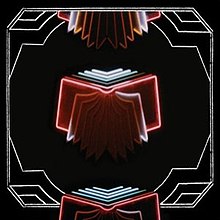Neon Bible
| Neon Bible | ||||
|---|---|---|---|---|
 |
||||
| Studio album by Arcade Fire | ||||
| Released | March 5, 2007 | |||
| Recorded | 2006 in Farnham, New York, Budapest, and London | |||
| Genre | ||||
| Length | 47:03 | |||
| Label | Merge | |||
| Producer | Markus Dravs, Arcade Fire | |||
| Arcade Fire chronology | ||||
|
||||
| Singles from Neon Bible | ||||
|
||||
| Professional ratings | |
|---|---|
| Aggregate scores | |
| Source | Rating |
| Metacritic | 87/100 |
| Review scores | |
| Source | Rating |
| AllMusic | |
| The A.V. Club | A |
| Entertainment Weekly | A− |
| The Guardian | |
| MSN Music | A+ |
| NME | 9/10 |
| Pitchfork | 8.4/10 |
| Q | |
| Rolling Stone | |
| Spin | |
Neon Bible is the second studio album by the Canadian indie rock band Arcade Fire, released on March 5, 2007 (UK) and March 6, 2007 (US) on Merge Records. Originally announced on December 16, 2006 through the band's website, the majority of the album was recorded at a church the band bought and renovated in Farnham, Quebec. The album is the first to feature drummer Jeremy Gara, and the first to include violinist Sarah Neufeld among the band's core line-up.
Neon Bible became Arcade Fire's highest charting album at the time, debuting on the Billboard 200 at number two, selling 92,000 copies in its first week and more than 400,000 to date. Being released within a month of similarly successful releases by The Shins (Wincing the Night Away) and Modest Mouse (We Were Dead Before the Ship Even Sank), Neon Bible was cited as an example of the popularization of indie rock. Critics offered the self-produced Neon Bible mostly favorable reviews, although with division over the album's sound. Publications like NME and IGN praised the album for its grandiose nature, while Rolling Stone and Uncut said that it resulted in a distant and overblown sound.
Following the release of Funeral (2004), which had been recorded in an attic studio known as Hotel2Tango, Arcade Fire decided a permanent recording location was necessary. Following their tour in support of Funeral, the band bought the Petite Église in Farnham, Quebec. Being used as a café at the time of purchase, the Petite Église had once been a church and a Masonic Temple. Once renovation of the church was complete, the band spent the latter half of 2006 recording a majority of the album there. Michael Pärt produced additionally recordings in Budapest, recording the Budapest Film Orchestra and a military men's choir. Other sessions included one in New York, where the band recorded along the Hudson River to be near water.
...
Wikipedia
